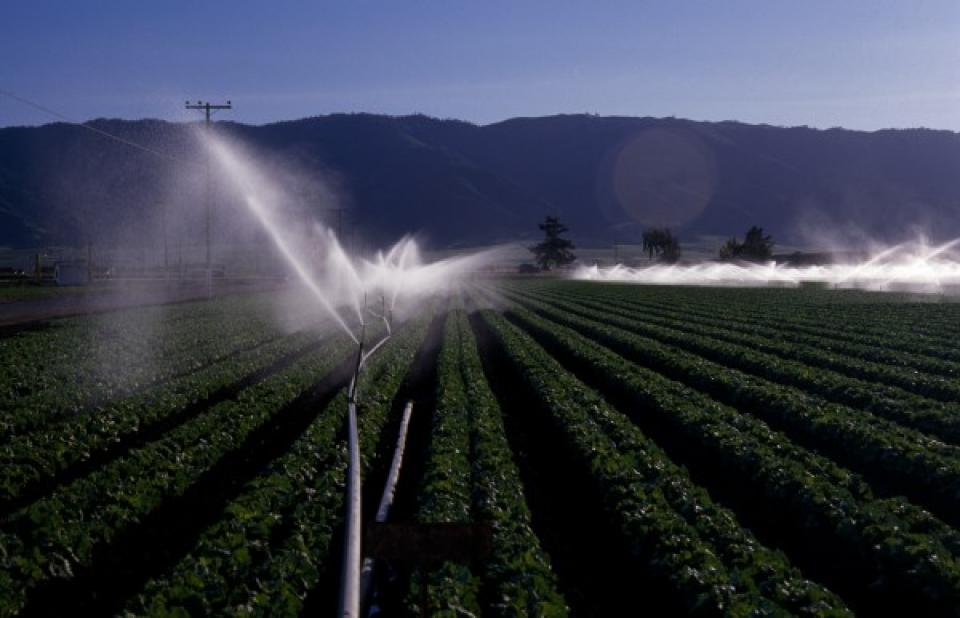Irrigation
 Irrigation is the artificial supply
of water to grow crops or plants. Obtained from either surface or groundwater, it optimizes
agricultural production when the amount of rain and where it
falls is insufficient. Different irrigation
systems are not necessarily mutually exclusive, but in
practical use are often combined. Much of the agriculture in
California and the West relies on irrigation.
Irrigation is the artificial supply
of water to grow crops or plants. Obtained from either surface or groundwater, it optimizes
agricultural production when the amount of rain and where it
falls is insufficient. Different irrigation
systems are not necessarily mutually exclusive, but in
practical use are often combined. Much of the agriculture in
California and the West relies on irrigation.
Irrigation in California
In 2017, some 7.8 million acres of California land was irrigated, composing most of the harvested farmland, according to the U.S. Department of Agriculture (USDA) Census of Agriculture.
California farmers used 10.6 million acre-feet of groundwater, 2.1 million acre-feet of on-farm surface water, and 11.7 million acre-feet of off-farm surface water for irrigation, the USDA’s 2017 Farm and Ranch Irrigation Survey (FRIS) reported.
Droughts reduce surface water resources, putting additional pressure on groundwater. Agricultural water users employ different methods to recharge groundwater, such as allowing water to seep through unlined canals and irrigating crops with surface water instead of groundwater. In some areas, agricultural water suppliers move surface water to recharge basins or spread it on fallowed land and open space to replenish groundwater for later use.
Evapotranspiration
In California’s growing regions, water applied to crops moves to the atmosphere via evaporation from the soil surface and transpiration from plants. The process is called evapotranspiration (ET), a combination of evaporation and transpiration, and is usually expressed as the depth of water in inches or the volume of water in gallons used by a planted area for a period of a day, week, month or year, according to the University of California’s Division of Agriculture and Natural Resources. The physiology and structure of plants affect evapotranspiration as do sunlight, air temperature, relative humidity and wind speed.
Evapotranspiration information is critical for irrigation system design and water management.
Categories of Irrigation
Center-pivot: In this unique type of sprinkler system, equipment pivots in a circle to water crops. To ensure that the entire field is watered, many plots utilizing center-pivot systems are designed to be circular.
Drip: Drip irrigation systems bring water directly to the roots of crops using orifices, emitters, porous tubing, perforated pipes, or other delivery methods. This targeted approach is considered one of the more efficient irrigation methods, reducing quantity of necessary water to irrigate the same area by between 30 and 50 percent compared to traditional sprinkler systems.
Flood: Perhaps the oldest method of irrigation, flood irrigation involves simply applying water to the entire surface of the soil and letting it flow freely. Flood irrigation still occurs, but it’s been replaced by concentrated watering around trees, vines and row crops. Technological advances automatically shut off water when the ground reaches a certain moisture level and farmers can order water on a day’s notice through a smart phone application.
Furrow: This is a slightly more specialized form of flood irrigation, in which the water is poured into furrows — also known as trenches — which are designed to irrigate the water between rows of crops.
Gravity: Instead of relying on pumps, gravity irrigation systems allow a reservoir’s placement above a field to instigate water’s natural flow to crops.
Rotation: More than a process itself, this category describes the process of distributing water to irrigators in scheduled allotments rather than continuously. This is done when reservoirs have major water deficits so as to account for canal flow and ensure equal allocation.
Sprinkler: Sprinkler irrigation pumps water via pipes or nozzles, then sprays it into the air to mimic rainfall, letting water fall onto crops as droplets.
Subirrigation: This system operates below the surface, either by raising the water table or pumping water to the roots.
Supplemental: This irrigation is meant for any crops that are regularly watered by natural rainfall in cases in which precipitation is insufficient. It is designed to provide the minimum amount of water necessary for crops during their critical growth stages.
Surface: Surface irrigation is a broad category referring to any irrigation method in which water is transported over the ground itself to get to its destination, rather than by pumps or similar conduits. Furrow irrigation would be a classic example.
Traveling Gun: Traveling gun sprinklers are mounted on a wheeled base and spray water while moving across a field.
Efficiency
The major obstacles to the effectiveness of irrigation methods are surface runoff, evaporation of water and deep percolation — or water soaking through soil only to miss crops’ roots entirely.
Gravity irrigation methods possess the benefit of low cost, but management and water quality are challenging to regulate.
Sprinkler irrigation is relatively simple to manage, but depends on wind for its efficiency.
Finally, drip irrigation bears high capital costs (as much as $1,000 per acre) and is sensitive to clogging, but is easy to manage and targets crops more effectively than its counterparts.








